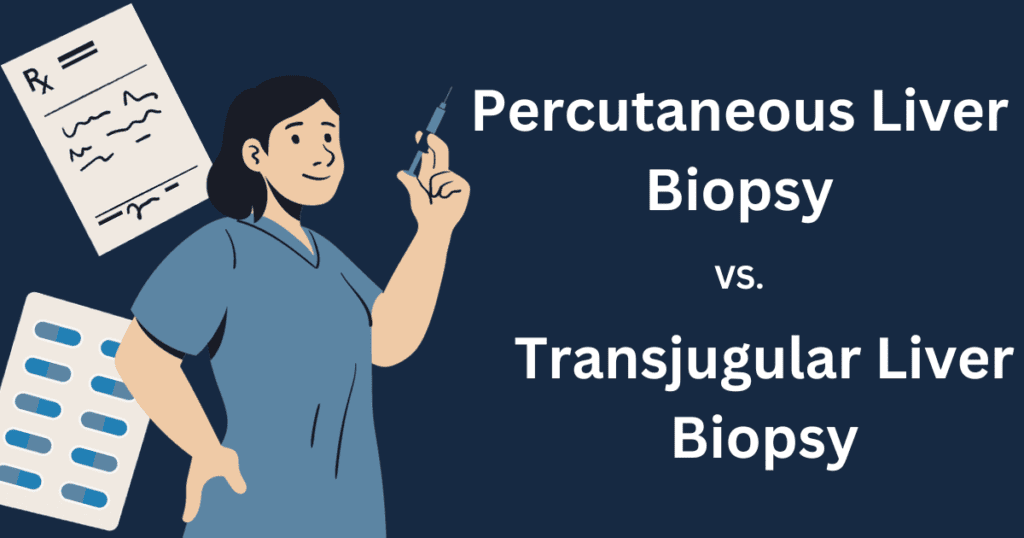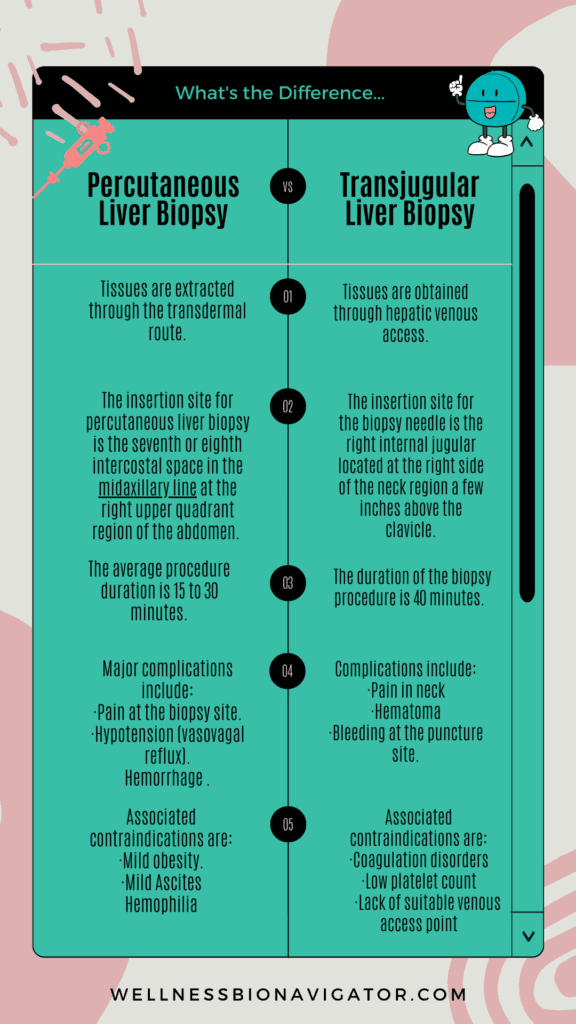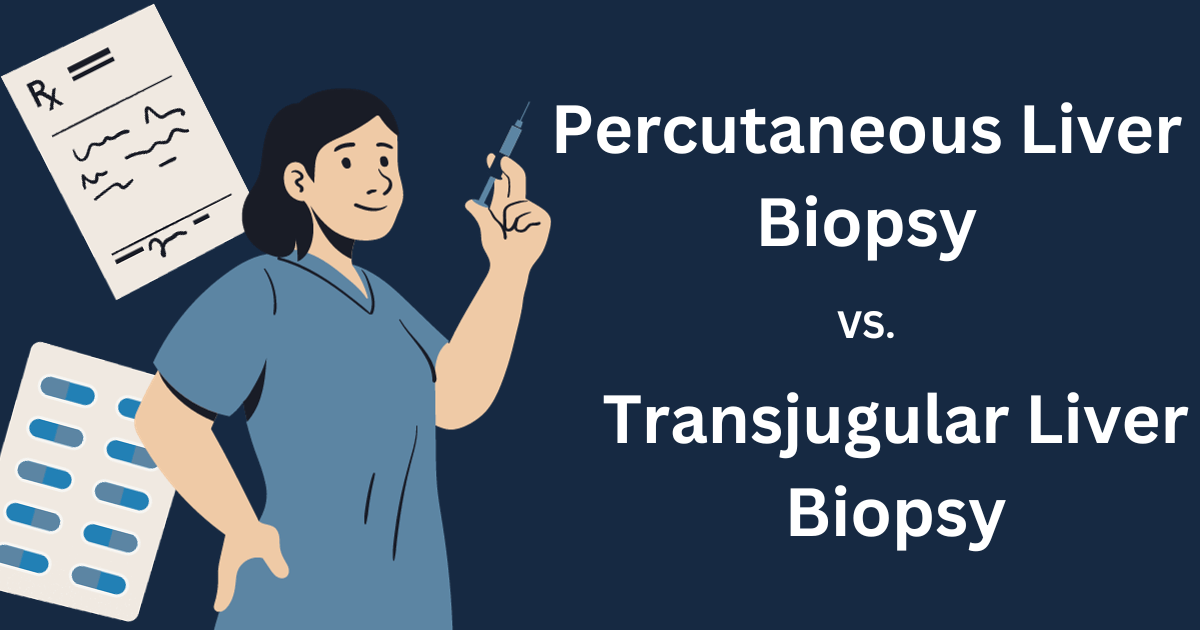Introduction:

The liver is an essential organ; we need to figure out what’s happening when it’s not working correctly. That’s where liver biopsies come in. They help doctors diagnose liver diseases. In this article, we’ll look at two methods for liver biopsies: Transjugular Liver Biopsy vs. Percutaneous Liver Biopsy: Which is Right for You? We’ll also help you understand the differences between them so that you can make informed decisions about your healthcare.
Before starting to compare both of them, let’s have a short intro to the two procedures.
Transjugular Liver Biopsy:
Transjugular Liver Biopsy is a relatively advanced hepatic biopsy in which the hepatocytes are extracted with the help of a rigid cannula through the hepatic venous pathway. The right jugular vein is used for the procedure. The sample is used to identify and examine the pathological issues associated with the liver.
Percutaneous Biopsy:
It is the conventional type of hepatic biopsy in which the liver tissues are obtained through a needle via a transdermal route. It is the most commonly used method worldwide.
Transjugular liver biopsy vs. Percutaneous liver biopsy?

-
INITIALLY PERFORMED BY?
Percutaneous Liver Biopsy: PLB is known to be first performed by Paul Ehrlich in 1883.
Transjugular Liver Biopsy: Transjugular liver biopsy (TJLB) was discussed by Dotter in 1964 and clinically performed by Hanafee in 1967.
-
NATURE OF PROCEDURE:
Percutaneous Liver Biopsy: It is performed with a needle and administered through the abdominal skin with the help of guided imaging techniques like X-rays and CT scans.
Transjugular Liver Biopsy: Tissue extract, with the help of a needle-associated rigid cannula, is introduced in one of the hepatic veins, particularly the right jugular vein.
-
COMMON INDICATIONS:
Percutaneous Liver Biopsy: Usually, if we are comparing transjugular liver biopsy vs. percutaneous biopsy, percutaneous biopsy has the same indications as liver biopsy; however, some of the indications are:
- Evaluation of abnormal hepatic and blood diagnostic tests when the pathological picture is unclear.
- To identify the staging associated with fibrosis and inflammation grading in various hepatic disorders.
- Quantitative estimation of iron (hemochromatosis) and copper (Wilson disease).
- To check drug toxicity.
- Diagnosis of after-transplantation lymphoproliferative disorder in case of liver transplantation.
Transjugular Liver Biopsy: Major indications for transjugular liver biopsy are:
- Those which are contraindicated with percutaneous liver biopsy or fail to percutaneous liver biopsy
- Patients requiring liver access and hemodynamic evaluation aid in their disease diagnosis and treatment, as in patients with portal hypertension.
- For patients who suffer from coagulative disorders (it is much safer because the blood loss during the procedure will drain into the hepatic vein as the Glisson’s capsule is not ruptured and eventually blood returns to the systemic circulation).
- Hydroperitoneum (excess abdominal fluid)
- Peliosis hepatis
- Atrophic liver.
- Peliosis hepatis.
-
SITE OF INSERTION:
Percutaneous Liver Biopsy: The accurate insertion site for percutaneous liver biopsy is the seventh or eighth intercostal space in the midaxillary line at the right upper quadrant region of the abdomen. The biopsy needle insertion site is further figured out through ultrasonography. It is usually taken through the skin (percutaneous).
Transjugular Liver Biopsy: The insertion site for the biopsy needle is the right internal jugular located at the right side of the neck region a few inches above the clavicle.
-
PROCEDURE DURATION:
Percutaneous Liver Biopsy: The average procedure duration is 15 to 30 minutes.
Transjugular Liver Biopsy: The duration of the biopsy procedure is 40 minutes.
-
BIOPSY NEEDLE:
Percutaneous Liver Biopsy: The needle used in percutaneous liver biopsy is a core biopsy needle, preferably 16 gauge, 11.5 cm.
Transjugular Liver Biopsy: True-cut 18G metal microneedle having a plastic cannula along with a wire guide (0.035 inches for 18G) is passed across the needle.
-
COMPLICATIONS:
Percutaneous Liver Biopsy: Major complications associated with the procedure include:
- Pain at the biopsy site.
- Hypotension (vasovagal reflux).
- Hemorrhage
- Tachycardia
- Biliary peritonitis
- Infection
- Portal vein thrombosis
Transjugular Liver Biopsy: Major complications associated with the procedure include:
- Pain in neck
- Hematoma
- Bleeding at the puncture site.
- Carotid artery puncture
- Ventricular arrhythmia
-
RECOVERY TIME:
Percutaneous Liver Biopsy: The biopsy-associated pain is usually gone within 24 hours, while within 1 to 3 days, the daily activities will be resumed.
Transjugular Liver Biopsy: recovery time is quick; usually, patients return to their daily life within 24 hours.
-
CONTRAINDICATIONS:
Percutaneous Liver Biopsy: The percutaneous biopsy-associated contraindications included:
- Mild obesity.
- Mild Ascites.
- Hemophilia.
- Thrombocytopenia.
- Extrahepatic biliary obstruction.
- Lack of incorporation.
- Use of blood thinning medications.
- Hemangioma, vascular tumor.
Transjugular Liver Biopsy: The associated contraindications are:
- Coagulation disorders
- Low platelet count
- Lack of suitable venous access point
- Focal liver lesion
- Bleeding disorder
-
SUCCESS RATE OF PROCEDURE:
Percutaneous Liver Biopsy: The success rate for percutaneous liver biopsy is 95.3%.
Transjugular Liver Biopsy: The success rate for transjugular liver biopsy is 96.8%.
-
THE PROCEDURE FACILITATION:
Percutaneous Liver Biopsy: The whole biopsy process is facilitated through three different types of techniques, which are:
- Palpation/percussion guided based on physical examination.
- The image emphasizes using ultrasonography to mark the biopsy site before needle insertion.
- Real-time image-guided requires the use of ultrasonography throughout the process.
Transjugular Liver Biopsy: The procedure is facilitated through fluoroscopy.
-
VITAL SIGNS MONITORING:
Percutaneous Liver Biopsy: During the procedure, the patient’s heart rate, blood pressure, and pain level will be monitored every 15 minutes.
Transjugular Liver Biopsy: Persistent BP, ECG, and Pulse oximeter monitoring throughout the process.
-
POST BIOPSY IDEAL RESTING POSITION:
Percutaneous Liver Biopsy: It is recommended to lie on the right side a few hours after the percutaneous liver biopsy to facilitate wound healing as a whole body weight is put on.
Transjugular Liver Biopsy: The sitting or semirecumbent position is the ideal resting position to avoid complications at the puncture site.
-
GUIDELINES FOR ADDITIONAL HEMATOLOGICAL ADMINISTRATION:
Percutaneous Liver Biopsy: The Society of Interventional Radiology suggested platelets administration if the platelets count is less than 50,000 per microliter.
Transjugular Liver Biopsy: In the case of transjugular liver biopsy, platelet administration is mandatory if the patient’s platelet count is less than 35,000 per microliter.
-
WHICH ONE IS MORE APPROPRIATE?
Transjugular liver biopsy vs percutaneous liver biopsy which is more appropriate? It always depends upon the patient’s pathological history, and after summarizing all the essential parameters, the healthcare will finalize to take one of both procedures.
Percutaneous Liver Biopsy: It is more suitable for patients with hepatic disorder; no other vasculature-related disease is present in the history.
Transjugular Liver Biopsy: It is usually suitable for patients with hepatic disorder and vasculature-related disorders like coagulopathy, thrombocytopenia, etc.
It is more appropriate for aged and pediatric patients.
Conclusion:
Getting a liver biopsy is an important step in diagnosing liver issues. Transjugular liver biopsy vs percutaneous liver biopsy both methods both have their pros and cons. However, it is thought that transjugular liver biopsy has been proven to be a safe and effective alternative to percutaneous liver biopsy. Talking with your healthcare team to determine which is best for you is crucial. Medical science is always advancing, so the best method for you might change with new technologies. Stay informed and trust your medical team to guide you on this journey. Your liver health is in good hands!
